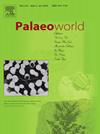浅水鲸落群落:来自埃及法尤姆 Wadi El-Hitan 中新世晚期玄武鲸骨的证据
IF 1.7
3区 地球科学
Q2 PALEONTOLOGY
引用次数: 0
摘要
本研究考察了从埃及法尤姆Wadi El-Hitan(鲸鱼谷)Sandouk El-Borneta地段采集的基龙类鲸骨标本。这些标本镶嵌在中始新世 Gehannam 和上始新世 Birket Qarun 地层的高化石钙质砂岩中。这些鲸骨显示了一些死后的变化,是鲸鱼陨落过程中至少三个不同阶段的良好迹象。鲨鱼、鳐鱼和鳄鱼化石标本与经检验的鲸骨同时出现,这可能表明第一阶段为移动清道夫阶段。鞘翅目多毛类的钻孔代表了最常见的蠕虫类型,它们对鲸骨进行了深度生物侵蚀,导致鲸骨迅速退化,代表了富集-机会主义阶段。这些食骨蠕虫化石痕迹是始新世区域内和区域间的首次记录,填补了晚白垩世和渐新世之间的空白。随后,所研究的鲸骨成为一些钙质管栖包壳多毛类、巴兰藤壶、片状螯足类和硬骨珊瑚的硬基质。此外,还观察到由多毛环毛虫产生的生物侵蚀结构。这些硬骨生物群的存在证实了这些鲸骨在最终埋葬前经过长期暴露和定殖,最终形成了发达的珊瑚礁阶段。根据所记录的死后变化以及其他沉积学和古生物学数据,所研究的鲸骨沉积在浅海开放海湾至遮蔽海湾环境中,这种环境的特点是沉积能量低、沉积速率低至中等、表层水生产力高。本文章由计算机程序翻译,如有差异,请以英文原文为准。
Shallow-water whale-fall communities: Evidence from the middle–late Eocene basilosaurid whale bones, Wadi El-Hitan, Fayum, Egypt
The present study examines the basilosaurid whale bone specimens collected from the Sandouk El-Borneta section, Wadi El-Hitan (Valley of Whales), Fayum, Egypt. These specimens are embedded in highly fossiliferous calcareous sandstones of the middle Eocene Gehannam and the upper Eocene Birket Qarun formations. These whale bones display some post-mortem alterations, representing good signs of at least three distinct stages in what is called the whale fall. The co-occurrence of shark, ray, and crocodile fossil specimens with the examined whale bones may indicate the first mobile-scavenger stage. Borings of the siboglinid polychaete genus Osedax represent the most common worm type that deeply bioeroded the whale bones, contributing to their rapid degradation, and representing the enrichment-opportunist stage. These fossil traces of the bone-eating worm Osedax represent the first record in the Eocene Epoch regionally and inter-regionally, filling the gap between the Late Cretaceous and the Oligocene occurrences. Subsequently, the studied whale bones served as hard substrates for some calcareous tube-dwelling encrusting polychaetes, balanoid barnacles, sheet‐like cheilostome bryozoans, and scleractinian corals. Furthermore, a bioerosion structure produced by polychaete annelids was also observed. The presence of these sclerobionts assemblage confirms the well-developed final reef stage with prolonged exposure and colonisation of these whale bones prior to final burial. Based on the recorded post-mortem alterations, together with other sedimentological and palaeontological data, the studied whale bones were deposited in a shallow open marine bay to sheltered gulf environments, which were characterised by low depositional energy, low to moderate rate of sedimentation, and high surface water productivity.
求助全文
通过发布文献求助,成功后即可免费获取论文全文。
去求助
来源期刊

Palaeoworld
PALEONTOLOGY-
CiteScore
4.00
自引率
5.90%
发文量
95
期刊介绍:
Palaeoworld is a peer-reviewed quarterly journal dedicated to the study of past life and its environment. We encourage submission of original manuscripts on all aspects of palaeontology and stratigraphy, comparisons of regional and global data in time and space, and results generated by interdisciplinary investigations in related fields. Some issues will be devoted entirely to a special theme whereas others will be composed of contributed articles. Palaeoworld is dedicated to serving a broad spectrum of geoscientists and palaeobiologists as well as serving as a resource for students in fields as diverse as palaeobiology, evolutionary biology, taxonomy and phylogeny, geobiology, historical geology, and palaeoenvironment.
Palaeoworld publishes original articles in the following areas:
•Phylogeny and taxonomic studies of all fossil groups
•Biostratigraphy, chemostratigraphy, chronostratigraphy
•Palaeoecology, palaeoenvironment and global changes throughout Earth history
•Tempo and mode of biological evolution
•Biological events in Earth history (e.g., extinctions, radiations)
•Ecosystem evolution
•Geobiology and molecular palaeobiology
•Palaeontological and stratigraphic methods
•Interdisciplinary studies focusing on fossils and strata
 求助内容:
求助内容: 应助结果提醒方式:
应助结果提醒方式:


